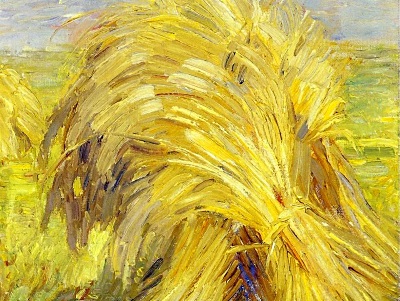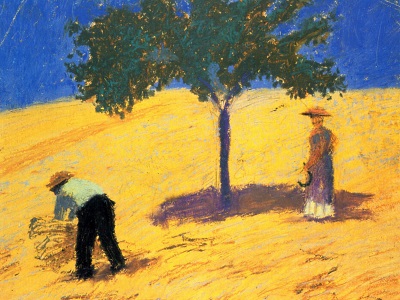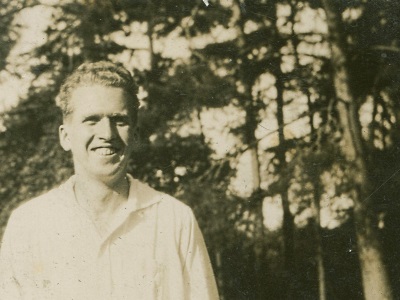This article is the fifth in a series on Eberhard Arnold and National Socialism. It follows Emmy Barth’s study, An Embassy Besieged, and page numbers are given in parentheses. The first article can be found here.
Image: The wedding procession of Heiner and Annemarie Arnold at the Alm Bruderhof, 1936.
Escape from Germany: 1935
At the beginning of 1935, Eberhard received word that the court had ruled in the Bruderhof’s favour concerning Emil Möller’s claim on the land. “It seemed to be a sign that they should remain in Germany, but they would have to pay 25,000 marks, the remainder of the purchase price, within three months” (209). The question of remaining in Germany, however, was soon to become more complicated. The Kassel deputy governor informed Eberhard in mid-February that compulsory military service was on the horizon. “A serious question faced the community: Should they remain in Germany and prepare to die, or should they flee? If they left the country, it should not be out of cowardice but in order to continue the witness of community and love” (213). Whatever was to transpire, the Bruderhof members expressed their willingness to follow Christ to the grave if need be. Eberhard affirmed this, though he also cautioned that martyrdom is easier to talk about than receive, citing Jesus’ words in Gethsemane, “My Father, if it is possible, let this cup pass from me” (Matt. 26:39).
On March 16, Hitler announced compulsory military service, effective immediately. The first of the Bruderhof to hear was Hans Meier in Zürich. He kept a close eye on the news, which was not subject to the same censorship in Switzerland as it was in Germany. At the end of that day, Meier had felt an urge to check back at the news office. Discovering the report, he hurried to a phone, calling Eberhard who had just arrived at the Rhön Bruderhof. Meier later recalled the coded language they used in case the Gestapo was listening in: “Eberhard asked me, ‘Is the weather good in Switzerland?’ And I said, ‘Yes, but in the north there is a storm brewing, and our friends from Berlin are going to invite our young men to go there.’ Eberhard immediately understood what that meant.”1 It was 6:30 pm. The Bruderhof finished their dinner, and when the members were alone Eberhard relayed the news to them. The men eligible for conscription would need to leave that very night.
The community had acquired a number of bikes for a time such as this. Members left after midnight and rode through the dark and the next day across almost 250 miles – or more in other cases – to Lindau on Lake Constance, where they could take the boat to Switzerland. They each went different ways, some making cautious use of trains to ease the difficulty of the journey. Across the next few days, all of them eventually arrived safely at the Alm Bruderhof. One member, Kathleen Hamilton, wrote at the time, “Some had considerable difficulty at the frontier, being detained and questioned; others got through easily.”2 The Alm Bruderhof was quite crowded now, but at least the men were safe. Some of the wives and children of the men were still at the Rhön Bruderhof. They arrived in a bus around two weeks later. The community in Liechtenstein sent a group back to Germany – members ineligible for military service – who would be able to continue work at the Rhön Bruderhof.
At the end of March, Eberhard travelled with Hardy to the Netherlands. The plan was to share the gospel and raise funds – money was still needed to complete the purchase of Emil Möller’s plot at the Rhön Bruderhof. They met some Mennonite leaders who embraced nonviolence, in contrast to the majority of German Mennonites, for example. They then crossed to England, visiting the Friends House (Quakers) and the community and activist hub, Kingsley Hall. Eberhard “was able to obtain a sizeable loan from the English Quakers for the Alm Bruderhof,” but, regarding the Rhön Bruderhof, “nobody was willing to invest money in Germany when the future there was so tenuous” (229). Important friendships that would be helpful later on were also founded throughout the trip.
With Eberhard away, however, some of the new arrivals in Liechtenstein who had come from the Rhön Bruderhof were low on their spirits and had lost enthusiasm for work. He wrote to Emmy, “To those who do not find a place to work or who do not fulfill their tasks, I am inclined to give the urgent advice to return to the Rhön Bruderhof to face a test of character in the military question and so prove their loyalty to their vows of faith…. We must not endanger ninety people because of the laziness of a few” (230). Otherwise, amid the difficulties – “the work was hard and the food was scarce” (231) – there were also moments of great encouragement. Kathleen Hamilton wrote at the time of a gift from another community: “It would require four tables to hold, so supper was cleared on the spot, people running about with their plates if not already finished – and then package after package was carried in. The wonder of it – eggs, cheese, dried fruit, sugar, ham. Clothes, wonderful baby clothes, shoes, and I don’t know what all. The din we made as the entire adult community celebrated the opening of each new sack or box brought the amazed youngsters from their beds to join in the joyful confusion…. The wonder of it – people whom we have seen once, and about whom we knew nothing a few weeks ago!! But where God’s will alone is sought, the result cannot but be a life of practical love.”3
In September, the Alm Bruderhof faced opposition from its neighbours. Ninety-five people from the area had signed a petition requesting an audience with the members in order to discuss misgivings that had arisen, namely, that the Bruderhof might host political dissidents, affecting the relationship of the small country to others; that the Bruderhof would purchase more land and negatively affect the economy; and that the size of the Bruderhof would result in a food shortage. In response, Eberhard met with the prime minister. He was then given a chance to speak at the local church, though the crowd proved difficult at first. Eventually, sympathy for the Bruderhof cause was found, and the citizens withdrew their concerns.
Eberhard’s contributions to Bruderhof meetings throughout October provide important reflections on the community’s role in this point in history. In mid-September, Hitler had changed the national flag to the swastika and announced the Nuremberg Laws, which curtailed further civil rights for Jews. This is the context that frames Eberhard’s words. Much of the material refers to the Book of Revelation, with Eberhard expounding the striking images of the two beasts for the state and the false church, the true church as Mary giving birth to Jesus, and the Heavenly Jerusalem. His words would have been a powerful encouragement to the members of the Bruderhof that they continue in the way of Christ despite the developments around them: “The reason we live in community is so that we may come before God with the power to pray and so that thereby world history may take a decisive turn, through the return of Christ, right through the end time.”4
By November 1935, Eberhard’s leg had still not healed. He travelled to Darmstadt near Frankfurt to consult his old friend who was a surgeon, joined by Emmy and Moni. He went into surgery on November 17. But “three days after the surgery, Eberhard developed a fever and suffered increasing discomfort” (242). It was Repentance Day in Germany. He loudly asked whether Joseph Goebbels had repented, continuing, “He will have to give account on the Day of Judgment for every idle word he has spoken.”5 Due to Eberhard’s worsening condition, the doctor recommended amputation. His initial prognosis was optimistic: “There is no danger to life, and the operation will take only twenty minutes.”6 But he didn’t know at the time how badly damaged the leg was. An arterial thrombosis was found above the knee, and much more of the leg would have to be removed. Eberhard’s life was drawing to a close. Barth summarizes, “Eberhard died on November 22, 1935. His body was brought to the Rhön Bruderhof in a closed casket because of the danger of infection. He was buried in the small burial plot on the hill behind the Rhön Bruderhof next to Else von Hollander [his sister-in-law]. Because of the threat of military draft his three sons Hardy, Heiner, and Hans-Hermann were not able to attend his funeral” (244).
Continue:
1. Overview and Literature
2. The Bruderhof under Nazi Rule: January–September 1933
3. Nazi Interest in the Bruderhof: October–December 1933
4. The Establishment of the Alm Bruderhof: 1934
5. Escape from Germany: 1935
6. Exiled to England: December 1935–1937
1. Unpublished interview, September 1984, cited in Barth, Embassy Besieged, 220.
2. Kathleen Hamilton to her mother, March 23, 1934, cited in Barth, Embassy Besieged, 224–25.
3. Kathleen Hamilton to her mother, June 7, 1935, cited in Barth, Embassy Besieged, 231.
4. Meeting Transcript, October 18, 1935 (EA 491b), cited in Barth, Embassy Besieged, 236–40. This citation is presented together with other material from October 1935. See Barth, Embassy Besieged, 293, notes to chapter 17.
5. Emmy Arnold, unpublished document, “Darmstadt Report,” cited in Barth, Embassy Besieged, 242.
6. Emmy Arnold, unpublished document, “Darmstadt Report,” cited in Barth, Embassy Besieged, 243–44.


